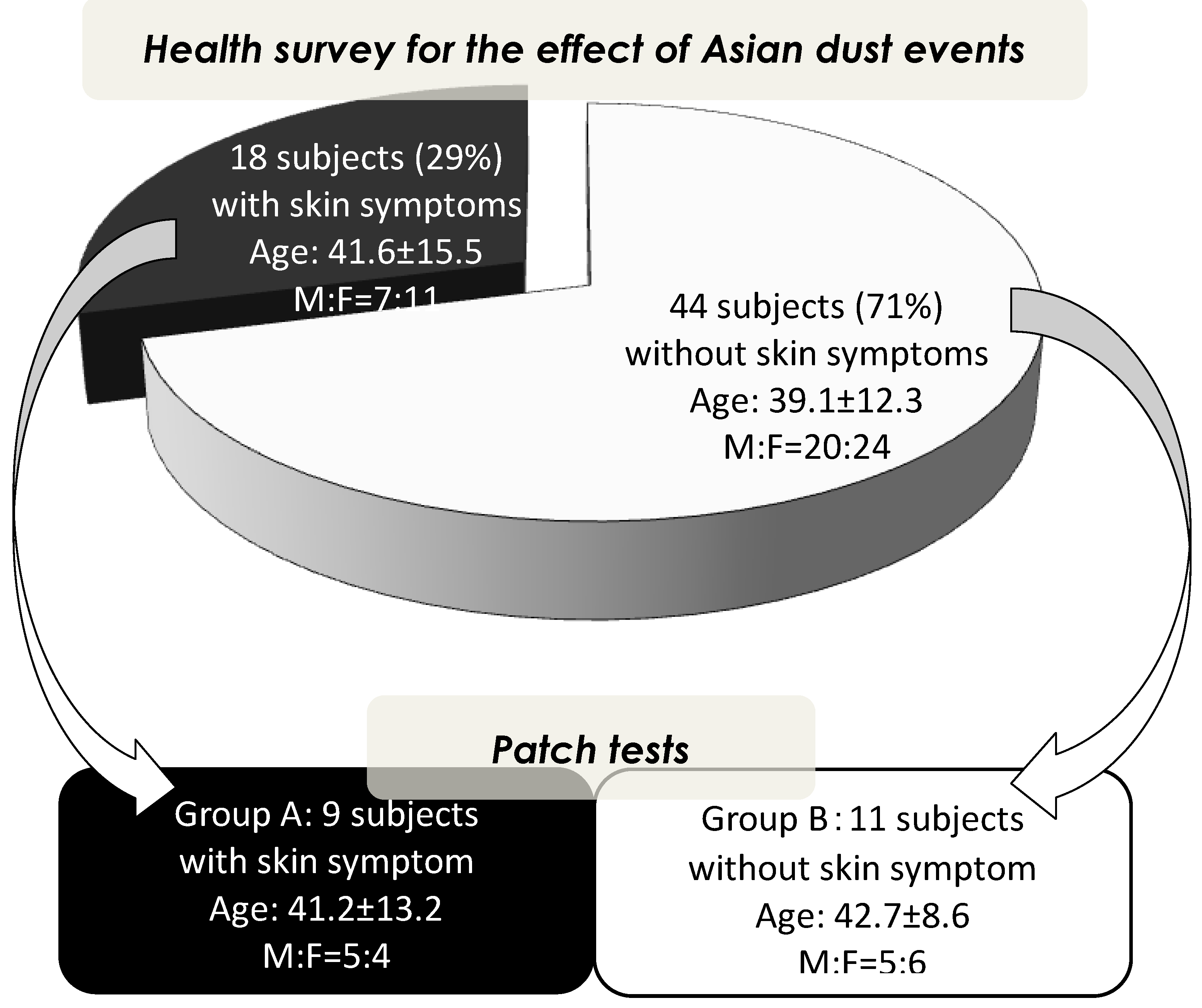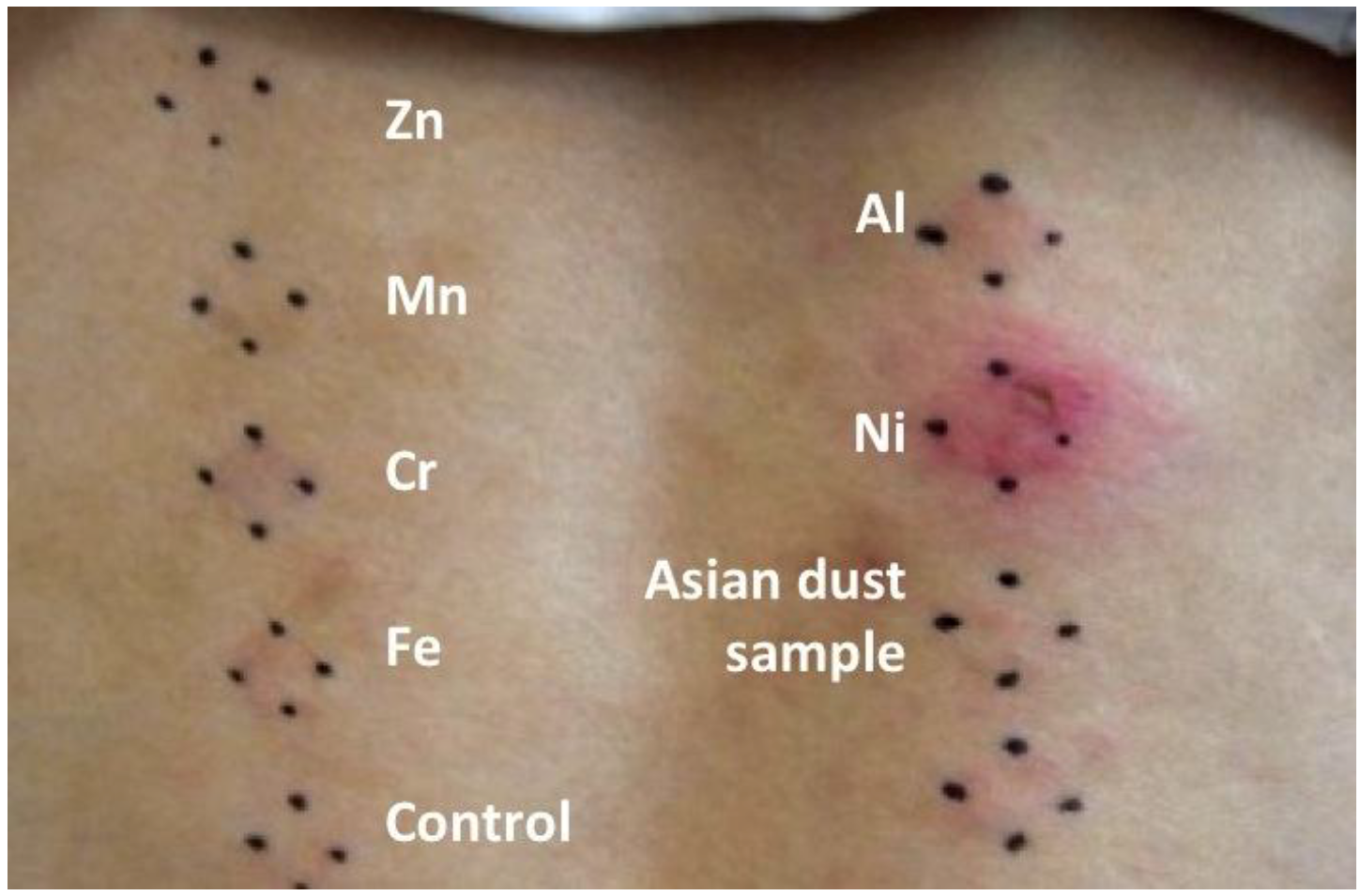The Relationship between Skin Symptoms and Allergic Reactions to Asian Dust
Abstract
:1. Introduction
2. Experimental Section
2.1. Health Survey on the Effects of Asian Dust Events
2.2. Asian Dust Day Data
2.3. Sampling and Measurement of Metal Elements in Total Suspended Particulates
2.4. Case-Control Study with Patch Tests

2.5. Statistical Analysis
3. Results and Discussion
3.1. Results

| The levels of the atmospheric metals | ||||||||||
| Date | Pb (ng/m3) | Cr (ng/m3) | Mn (ng/m3) | Cd (ng/m3) | Ni (ng/m3) | Cu (ng/m3) | Zn (ng/m3) | Fe (μg/m3) | Ca (μg/m3) | Al (μg/m3) |
| March 20 | 26.2 | 6.0 | 39.4 | 0.9 | 4.3 | 10.0 | 74.6 | 1.3 | 1.7 | 1.0 |
| March 21 | 57.2 | 46.0 | 584.9 | 1.9 | 33.3 | 36.2 | 199.5 | 15.2 | 13.6 | 9.3 |
| March 22 | 10.8 | 2.3 | 14.4 | 0.2 | 1.2 | 2.8 | 29.1 | 0.5 | 0.7 | 0.5 |
| The levels of the atmospheric metals in the corrected total suspended particulates | ||||||||||
| Date | Pb (mg/kg) | Cr (mg/kg) | Mn (mg/kg) | Cd( mg/kg) | Ni (mg/kg) | Cu (mg/kg) | Zn (mg/kg) | Fe (g/kg) | Ca (g/kg) | Al (g/kg) |
| March 19 to 23 | 102 | 96 | 960 | 3 | 51 | 62 | 505 | 38 | 34 | 63 |
| Sample | Group | +++ | ++ | + | ± | - | p value |
|---|---|---|---|---|---|---|---|
| Zn * | A | 0 (0%) | 0 (0%) | 1 (11%) | 1 (11%) | 7 (78%) | 0.189 |
| B | 0 (0%) | 0 (0%) | 0 (0%) | 0 (0%) | 11 (100%) | ||
| Mn * | A | 0 (0%) | 0 (0%) | 0 (0%) | 0 (0%) | 9 (100%) | 1.000 |
| B | 0 (0%) | 0 (0%) | 0 (0%) | 1 (9%) | 10 (91%) | ||
| Cr | A | 0 (0%) | 1 (11%) | 2 (22%) | 1 (11%) | 5 (55%) | 0.279 |
| B | 0 (0%) | 0 (0%) | 1 (9%) | 0 (0%) | 10 (91%) | ||
| Fe | A | 0 (0%) | 2 (22%) | 3 (33%) | 1 (11%) | 3 (33%) | 0.015 |
| B | 0 (0%) | 0 (0%) | 0 (0%) | 0 (0%) | 11 (100%) | ||
| Al | A | 0 (0%) | 0 (0%) | 3 (33%) | 1 (11%) | 5 (55%) | 0.047 |
| B | 0 (0%) | 0 (0%) | 0 (0%) | 0 (0%) | 11 (100%) | ||
| Ni | A | 2 (22%) | 2 (22%) | 1 (11%) | 3 (33%) | 1 (11%) | 0.008 |
| B | 0 (0%) | 0 (0%) | 2 (18%) | 0 (0%) | 9 (82%) | ||
| D | A | 0 (0%) | 0 (0%) | 2 (22%) | 2 (22%) | 5 (55%) | 0.047 |
| B | 0 (0%) | 0 (0%) | 0 (0%) | 0 (0%) | 11 (100%) |

3.2. Discussion
4. Conclusions
Acknowledgements
Conflict of Interest
References
- Kurosaki, Y.; Shinoda, M.; Mikami, M. What caused a recent increase in dust outbreaks over East Asia? Geophys. Res. Lett. 2011, 38, 6. [Google Scholar]
- Yang, C.Y.; Tsai, S.S.; Chang, C.C.; Ho, S.C. Effects of Asian dust storm events on daily admissions for asthma in Taipei, Taiwan. Inhal. Toxicol. 2011, 17, 817–821. [Google Scholar]
- Kanatani, K.T.; Ito, I.; Al-Delaimy, W.K.; Adachi, Y.; Mathews, W.C.; Ramsdell, J.W. Toyama Asian Desert Dust and Asthma Study Team. Desert dust exposure is associated with increased risk of asthma hospitalization in children. Am. J. Resp. Crit. Care 2010, 182, 1475–1481. [Google Scholar] [CrossRef]
- Ueda, K.; Nitta, H.; Odajima, H. The effects of weather, air pollutants, and Asian dust on hospitalization for asthma in Fukuoka. Environ. Health Prev. Med. 2010, 15, 350–357. [Google Scholar] [CrossRef]
- Chang, C.C.; Lee, I.M.; Tsaic, S.S.; Yanga, C.C. Correlation of Asian dust storm events with daily clinic visits for allergic rhinitis in Taipei, Taiwan. J. Toxicol. Env. Heal. A 2006, 69, 229–235. [Google Scholar] [CrossRef]
- Yang, C.Y. Effects of Asian dust storm events on daily clinical visits for conjunctivitis in Taipei, Taiwan. J. Toxicol. Env. Heal. A 2006, 69, 1673–1680. [Google Scholar] [CrossRef]
- Otani, S.; Onishi, K.; Mu, H.; Kurozawa, Y. The effect of asian dust events on the daily symptoms in Yonago, Japan: a pilot study on healthy subjects. Arch. Environ. Occup. Health 2011, 66, 43–46. [Google Scholar] [CrossRef]
- Onishi, K.; Otani, S.; Yoshida, A.; Mu, H.; Kurozawa, Y. Adverse health effects of asian dust particles and heavy metals in Japan. Asia Pac. J. Public Health. 2012. Available online: http://aph.sagepub.com/content/early/2012/07/18/1010539511428667.long (accessed on 18 October 2012).
- Nonaka, H.; Nakada, T.; Ijima, M.; Maibach, H.I. Metal patch test results from 1990-2009. J. Dermatol. 2011, 38, 267–271. [Google Scholar] [CrossRef]
- Santos, R.; Goossens, A. An update on airborne contact dermatitis: 2001-2006. Contact Dermatitis 2007, 57, 353–360. [Google Scholar] [CrossRef]
- Mann, E.; Ranft, U.; Eberwein, G.; Gladtke, D.; Sugiri, D.; Behrendt, H.; Ring, J.; Schäfer, T.; Begerow, J.; Wittsiepe, J.; et al. Does airborne nickel exposure induce nickel sensitization? Contact Dermatitis 2010, 62, 355–362. [Google Scholar] [CrossRef]
- Onishi, K.; Kurosaki, Y.; Otanib, S.; Yoshidac, A.; Sugimotod, N.; Kurozawaa, Y. Atmospheric transport route determines components of Asian dust and health effects in Japan. Atmos. Environ. 2012, 49, 94–102. [Google Scholar] [CrossRef]
- Watanabe, M.; Igishi, T.; Burioka, N.; Yamasaki, A.; Kurai, J.; Takeuchi, H.; Sako, T.; Yoshida, A.; Yoneda, K.; Fukuoka, Y.; et al. Pollen augments the influence of desert dust on symptoms of adult asthma patients. Allergology Int. 2011, 60, 517–524. [Google Scholar] [CrossRef]
- Ichinose, T.; Yoshida, S.; Sadakane, K.; Takano, H.; Yanagisawa, R.; Inoue, K.; Nishikawa, M.; Mori, I.; Kawazato, K.; Yasuda, A.; Shibamoto, T. Effects of asian sand dust, Arizona sand dust, amorphous silica and aluminum oxide on allergic inflammation in the murine lung. Inhal. Toxicol. 2007, 20, 685–694. [Google Scholar]
- Handa, S.; De, D.; Mahajan, R. Airborne contact dermatitis—Current perspectives in etiopathogenesis and management. Indian J. Dermatol. 2011, 56, 700–706. [Google Scholar] [CrossRef]
- Maki, T.; Susuki, S.; Kobayashia, F.; Kakikawab, M.; Toboc, Y.; Yamadad, M.; Higashie, T.; Matsukic, A.; Hongc, C.; Hasegawaa, H.; et al. Phylogenetic analysis of atmospheric halotolerant bacterial communities at high altitude in an Asian dust (KOSA) arrival region, Suzu City. Sci. Total Environ. 2010, 408, 4556–4562. [Google Scholar]
- Chao, H.J.; Chan, C.C.; Rao, C.Y.; Lee, C.T.; Chuang, Y.C.; Chiu, Y.H.; Hsu, H.H.; Wu, Y.H. The effects of transported Asian dust on the composition and concentration of ambient fungi in Taiwan. Int. J. Biometeorol. 2012, 56, 211–219. [Google Scholar] [CrossRef]
- Yamaguchi, N.; Ichijo, T.; Sakatani, A.; Baba, T.; Nasu, M. Global dispersion of bacterial cells on Asian dust. Sci. Rep. 2012, 2, 525. [Google Scholar]
© 2012 by the authors; licensee MDPI, Basel, Switzerland. This article is an open-access article distributed under the terms and conditions of the Creative Commons Attribution license (http://creativecommons.org/licenses/by/3.0/).
Share and Cite
Otani, S.; Onishi, K.; Mu, H.; Yokoyama, Y.; Hosoda, T.; Okamoto, M.; Kurozawa, Y. The Relationship between Skin Symptoms and Allergic Reactions to Asian Dust. Int. J. Environ. Res. Public Health 2012, 9, 4606-4614. https://doi.org/10.3390/ijerph9124606
Otani S, Onishi K, Mu H, Yokoyama Y, Hosoda T, Okamoto M, Kurozawa Y. The Relationship between Skin Symptoms and Allergic Reactions to Asian Dust. International Journal of Environmental Research and Public Health. 2012; 9(12):4606-4614. https://doi.org/10.3390/ijerph9124606
Chicago/Turabian StyleOtani, Shinji, Kazunari Onishi, Haosheng Mu, Yae Yokoyama, Takenobu Hosoda, Mikizo Okamoto, and Youichi Kurozawa. 2012. "The Relationship between Skin Symptoms and Allergic Reactions to Asian Dust" International Journal of Environmental Research and Public Health 9, no. 12: 4606-4614. https://doi.org/10.3390/ijerph9124606




